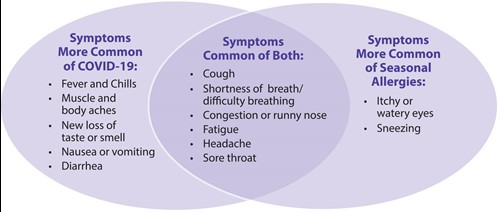

Culturally, we tend to see illness as a weakness. We drag ourselves to work even when we have minor injuries and mild illnesses like colds. The pandemic and the unusual rules we’re living with forces us to think hard about whether to go to work if we’re not feeling well.
In order to get through the pandemic and keep our communities safe, we’ve had to shift our culture. It’s no longer okay to show up at work with a runny nose. If you have a fever, you’ll be sent home—maybe for two weeks. Now, every sniffle and cough makes us question if we’ve been exposed to the coronavirus.
So, those of us who suffer from seasonal allergies are constantly on edge, wondering if we’re actually sick with COVID-19, or if we’re just reacting to mold and pollen. The Centers for Disease Control and Prevention (CDC) made lists of symptoms common to COVID-19, common to seasonal allergies, and common to both. These lists aren’t all-inclusive; there are other possible symptoms of COVID-19 and seasonal allergies. Also, symptoms range from mild to severe and vary from person to person. It’s also possible for someone to be infected with COVID-19—and contagious—without showing any symptoms at all. And it’s possible to have symptoms of both COVID-19 and seasonal allergies at the same time.

If you think you have COVID-19, don’t go to work. Check with your doctor. The CDC has a web page with advice, you can access it here. If you have: chest pain, trouble breathing, confusion, trouble staying awake, or bluish lips or skin, get emergency medical care immediately.
Talk with your doctor about how to manage your seasonal allergy symptoms. Call your doctor or the local health department if you think you’ve been exposed to coronavirus. Stay safe and stay healthy.
Health Covid